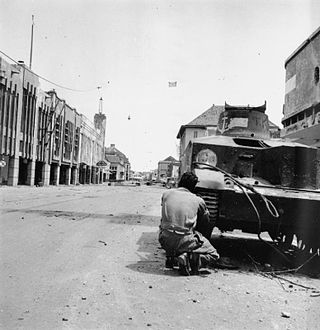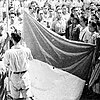
Banten is the westernmost province on the island of Java, Indonesia. Its capital city is Serang and its largest city is Tangerang. The province borders West Java and the Special Capital Region of Jakarta on the east, the Java Sea on the north, the Indian Ocean on the south, and the Sunda Strait on the west and shares a maritime border with Lampung to the west. The province covers an area of 9,352.77 km2 (3,611.12 sq mi). It had a population of over 11.9 million in the 2020 census, up from about 10.6 million in 2010. The estimated mid-2023 population was 12.308 million. Formerly part of the province of West Java, Banten was split off to become a province on 17 October 2000.

Tangerang is the city with the largest population in the province of Banten, Indonesia. Located on the western border of Jakarta, it is the sixth largest city proper in the nation. It has an area of 164.55 km2 (63.53 sq mi) and an official 2010 Census population of 1,798,601, which had risen to 1,895,486 at the 2020 Census – making it the eighth most populated suburb in the world at the latter date; the official estimate as at mid 2023 was 1,912,679 - comprising 961,354 males and 951,325 females.

The Battle of Surabaya was a major battle in the Indonesian National Revolution fought between regular infantry and militia of the Indonesian nationalist movement and British and British Indian troops against the re-imposition of Dutch colonial rule. The peak of the battle was in November 1945. The battle was the largest single battle of the revolution and became a national symbol of Indonesian resistance. Considered a heroic effort by Indonesians, the battle helped galvanise Indonesian and international support for Indonesian independence. 10 November is celebrated annually as Heroes' Day.

The Bandung Sea of Fire refers to the deliberate burning of much of the southern side of the city of Bandung by retreating Indonesian Republican troops during the Indonesian National Revolution.

Alexander Evert Kawilarang was an Indonesian freedom fighter, military commander, and founder of Kesko TT, which would become the Indonesian special forces unit Kopassus. However, in 1958 he resigned his post as military attaché to the United States to join the rebel Permesta movement where he encountered Kopassus as his opponent. His involvement in Permesta damaged his military career, but he remained popular and active in the armed forces community.

Pierre Andries Tendean was an Indonesian Army lieutenant. He was best known as a victim of the 30th September Movement (G30S) and posthumously awarded as revolution hero, later Indonesian national hero.

The Defenders of the Homeland was a volunteer army established on 3 October 1943 in the Dutch East Indies by the occupying Japanese. The Japanese intended PETA to assist their forces in opposing a possible invasion by the Allies. By the end of World War II, there were a total of 69 battalions in Java, Madura, and Bali and Sumatra. On 17 August 1945, the day after the Proclamation of Indonesian Independence, the Japanese ordered the PETA daidan to surrender and hand over their weapons, which most of them did. Indonesia's inaugural President, Sukarno, supported the dissolution rather than turning the organisation into a national army as he feared allegations of collaboration had he allowed a Japanese-created militia to continue to exist.

The Trisakti shootings, also known as the Trisakti tragedy, took place at Trisakti University, Jakarta, Indonesia, on 12 May 1998. At a demonstration demanding President Suharto's resignation, Indonesian Army soldiers opened fire on unarmed protestors. Four students, Elang Mulia Lesmana, Heri Hertanto, Hafidin Royan, and Hendriawan Sie, were killed and dozens more were injured. The shootings triggered a riot and nationwide revolutionary wave, leading to Suharto's resignation later the same month.
The Tanjung Priok massacre was an incident that occurred on 12 September 1984, in the port area of Tanjung Priok, Jakarta, Indonesia. Government reports give a total of 24 killed and 54 injured, while survivors report over 100 killed when military personnel opened fire on protestors.

Merah Putih is a movie, directed by Yadi Sugandi, brought out in Indonesia in 2009. This film is an adaptation of Japanese propaganda film Air dan Api by Andreas Liong and Ignatius Matulessy in 1943.
Andi Djemma was a king of Luwu in South Sulawesi and Indonesian nationalist who later supported inclusion of his own kingdom to the newly formed Indonesian Republic.

Major Daniel Elias Mogot was a military officer involved in the Indonesian National Revolution. He was part of a group that established the Tangerang Military Academy and became its first director. He was killed during the Lengkong incident, an attempt to disarm a Japanese army depot in Lengkong.
2017 (MMXVII) was a common year starting on Sunday of the Gregorian calendar, the 2017th year of the Common Era (CE) and Anno Domini (AD) designations, the 17th year of the 3rd millennium and the 21st century, and the 8th year of the 2010s decade.

Brig. Gen. Daan Jahja or Daan Yahya was an Indonesian military officer who was the Chief of Staff of the Siliwangi Division in 1948 and the Military Governor of Jakarta from 1949 to 1950.
The Arfai incident was a skirmish between Indonesian Army soldiers and Free Papua Movement fighters backed by local sympathizers on 28 July 1965, where the fighters launched a raid against an Indonesian barracks in an attempt to capture firearms.
The Talangsari incident was an incident that occurred in the village of Talangsari, Lampung, Indonesia in 1989, where Islamist civilians were massacred by Indonesian Army troops. The civilians had formed an Islamist commune, which developed tensions with local residents and authorities.
The Kolaka incident, known locally as the 19 November incident, was an ambush of a Dutch military convoy near Kolaka, Southeast Sulawesi on 19 November 1945, during the early months of the Indonesian National Revolution.

Tadjus Sobirin is an Indonesian former military officer and politician who was the regent of Tangerang Regency between 1983 and 1993.

General Zulkifli Lubis was Chief of Staff of the Indonesian Army from 8 May 1955 to 26 June 1955 and founder and first Chairman of the first Intelligence Agency in Indonesia.
Benius Petrus Peter Lengkong, better known as Petrus Lengkong, was an Indonesian artist and former Indonesian Army officer best known for popularizing Dayak arts, especially wood carving and sculpture. Due to his work in preserving Dayak arts and culture, he received several awards from Indonesian government.













